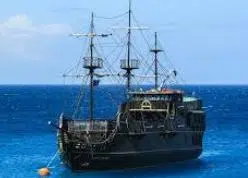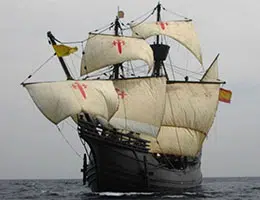 The Byzantine Greek word kárabos , which can be translated as "beetle" , was used to name a light boat . The etymological journey of the term was extensive until it reached our language as caravel .
The Byzantine Greek word kárabos , which can be translated as "beetle" , was used to name a light boat . The etymological journey of the term was extensive until it reached our language as caravel .
A caravel, therefore, is a light sailing ship that has a single deck and flat stern. It has three masts with three sails and can sail at a speed of about eight knots.
These boats were very important in the 15th and 16th centuries. In fact, many European conquerors used caravels on the voyages that took them to the American continent.
Caravels offered several advantages over other ships of that time. They did not require rowers for propulsion and had a significant carrying capacity: that is why they could transport large quantities of food for extensive journeys.
After the conquest of America , caravels began to lose preponderance because, little by little, sailors began to opt for other vessels, such as galleons .
Possibly the most famous caravels in history are those that were part of the expedition that took Christopher Columbus and his crew to American territory for the first time. The Santa María was the largest ship: some historians doubt whether it was a caravel or a ship. La Niña and La Pinta were the other caravels that allowed the voyage to develop.
The ship , for its part, was a vessel equipped with a sail and deck that did not require oars for its operation. The term comes from the Latin navis , which can be translated as "ship", and then crossed the Galician-Portuguese language. Although from the 14th century to the 17th century, this concept was understood with the definition provided above, later it began to be used to refer to a class of ship characterized by having castles in the stern and bow, a high freeboard and three masts. with square sails.
Round caravels emerged when sailors began to use both square and lateen sails on the boat (the first is square and the second has a triangular shape). Shortly before the team in charge of Christopher Columbus began its historic voyage, La Niña and La Pinta , until then considered Latin caravels, were modified to become round ones.
 Needless to say, the emergence of round caravels was not a whim of a stylistic nature, but rather took place with the aim of improving the maneuverability of the ships.
Needless to say, the emergence of round caravels was not a whim of a stylistic nature, but rather took place with the aim of improving the maneuverability of the ships.
For example, the square sail is not capable of sticking to a headwind (that is, unfavorable) more than fifty percent, even if the boat is well balanced and the crew is made up of very experienced people; Likewise, it tends to make the caravel drift. But all this changes when the two types of sail are combined, since the lateen does not have either of these two problems.
If the wind is favorable (the so-called following wind ), the situation is reversed: while the unequal pressure makes it very difficult to keep the ship on the path drawn with a lateen sail, the stable can take advantage of all the wind and allows it to advance with full uniformity.
There was also a boat called barcusium , which was very similar to the Latin caravel. It also operated under sail, it had two masts and three rudders. Its creation took place in the Sicilian city of Ragusa, where its use predominated.
In the context of zoology , the aquatic animal whose scientific name is Physalia physalis is known as the Portuguese man-of-war . It is a hydrozoan that belongs to the order of siphonophores.
